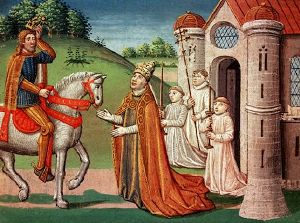Adrian I
Pope Adrian, or Hadrian I, (d. December 25, 795) was pope from February 9, 772 to December 25, 795. He was the son of Theodore, a Roman nobleman.

Early Life
Soon after his accession, the territory ruled by the popes was invaded by Desiderius, king of the Lombards, and Adrian found it necessary to invoke the aid of the Frankish king Charlemagne, who entered Italy with a large army, besieged Desiderius in his capital of Pavia, took that town, banished the Lombard king to Corbie in France and, in an innovative gesture, took the title 'King of the Lombards' himself. The pope, whose expectations had been aroused, had to content himself with some additions to the duchy of Rome, and to the Exarchate of Ravenna, and the Pentapolis in the Marches, which consisted of the "five cities" on the Adriatic coast from Rimini to Ancona with the coastal plain as far as the mountains.
In his contest with the Byzantine Empire and the Lombard dukes of Benevento, Adrian remained faithful to the Frankish alliance, and the friendly relations between pope and king were not disturbed by the difference which arose between them on the question of the veneration of images, to which Charlemagne and the bishops in France were strongly opposed, while Adrian favoured the views of the Eastern Church, and approved the decree of the second council of Nicaea (787), confirming the practice and excommunicating the iconoclasts. It was in connection with this controversy that the Libri Carolini were written, to which Adrian replied by letter, anathematizing all who refused to venerate the images of Jesus, or the Virgin Mary, or saints. Notwithstanding this, a synod, held at Frankfurt in 794, anew condemned the practice, and the dispute remained unsettled at Adrian's death.
In 787, he elevated the diocese of Lichfield, in England, to an archdiocese on request from the English bishops and King Offa of Mercia in order to balance the ecclesiastic power in that land between Kent and Mercia. He gave the Lichfield bishop Higbert the pallium in 788.
An epitaph written by Charlemagne in verse, in which he styles Adrian "father," is still to be seen at the door of the Vatican basilica. Adrian restored some of the ancient aqueducts of Rome, and rebuilt the churches of Santa Maria in Cosmedin, decorated by Greek monks fleeing from the iconoclastal persecutions, and of San Marco in Rome. At the time of his death, his was the longest papacy since Saint Peter, and it would remain so until he was surpassed by the 24-year papacy of Pius VI in the late 18th century. In fact, only three more popes (Pius IX, John Paul II and Leo XIII) have reigned longer since.
See also
- List of 10 longest-reigning popes
ReferencesISBN links support NWE through referral fees
- This article incorporates text from the Encyclopædia Britannica Eleventh Edition, a publication now in the public domain.
- Bower, Archibald The History of the Popes, Boston: Adamant Media, 2001 ISBN 978-1402171796
- Duffy, Eamon Saints and Sinners: A History of the Popes, New Haven, CT: Yale University Press, 2006 ISBN978-0300115970
- Maxwell-Stuart, P. G Chronicle of the Popes: The Reign-by-Reign Record of the Papacy over 2000 years,London: Thames & Hudson, 1997 ISBN 978-0500017982
External links
- Partial letter of Pope Hadrian to the 2nd session of the Seventh Ecumenical Council Retrieved September 8, 2007.
Credits
New World Encyclopedia writers and editors rewrote and completed the Wikipedia article in accordance with New World Encyclopedia standards. This article abides by terms of the Creative Commons CC-by-sa 3.0 License (CC-by-sa), which may be used and disseminated with proper attribution. Credit is due under the terms of this license that can reference both the New World Encyclopedia contributors and the selfless volunteer contributors of the Wikimedia Foundation. To cite this article click here for a list of acceptable citing formats.The history of earlier contributions by wikipedians is accessible to researchers here:
The history of this article since it was imported to New World Encyclopedia:
Note: Some restrictions may apply to use of individual images which are separately licensed.